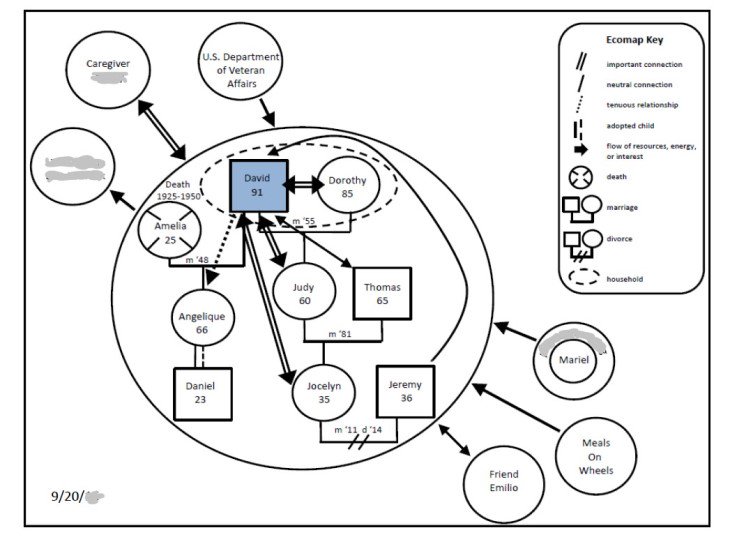

Excellent Ecomap depicts family and many interactions, clear When working with a young persons family, there may be some disagreement amongst family members about the quality of the relationships and level and nature of support provided by extended family, friends, church, school and other external sources. Legend is present, but not complete or clearly written. Social services or nurses will examine them whenever they need to.Ecomap depicts family and interactions some weights and arrows, hazy relationships Significant environmental and social systems not shown clearly. Refugees and migrants can also have an ecomap for one person or the whole family. It is advisable for every person involved in the counseling within the social work to have one. Landlord (Tenant) Recommendation LetterThe genogram and ecomap both framed as an analytical tool in relation while performing family nursing assessment, which aims to understand how the family of a young person with chronic disease and new addition to the family, faces the disease and its implications, forming care, and creating support networks to help them through this process.Ecomap is the visual representation of different spheres of an individual’s life and his relation to them.
The client was in the center of this drawing, meaning he played a key role in the whole process. She put circles with various individual’s or family’s connections to the external world on one paper. And do it in a short period. In 1975 she decided to create a tool helping social workers to know their wards better. It may help to elicit each family members beliefs about the role of family and community and somThe idea of ecomaps belongs to Ann Hartman, who was a sociologist of the 20th century.
The ecomaps give workers a detailed picture.Many psychotherapists use them during initial sessions to create a clear picture of the person’s social issues. Since that time, ecomaps have become an indispensable part of the social work procedure.Creating an ecomap is a graphic and useful way of identifying all of the systems at play in the familys life. That’s how the ecomap was invented.
Here’s a list of social life items you need to cover there. Note that before deciding whether to draw your ecomap or not.In reality, the information specified in your ecomap is quite common. However, it can make life easier for both parts of the social work process. Not every person wants to show his private information to anyone. What Can an Ecomap Say About You?Drawing an ecomap and sharing it with nurses, therapists, and social workers might be a tough decision. In the future, it will help them to build a trusting relationship with their clients, leaning on the ecomap results.
You can do it by drawing lines of different shapes and thicknesses. Where you can find support except familyYou also need to specify the quality of your relationships in all these spheres. Your relations with people of common cultural background
Meanwhile, closed boundaries show the intense atmosphere within the family members and also their mistrust of other people and the external world. Open boundaries mean there’s a healthy atmosphere within the family itself. They can conclude whether the boundaries between the environment and family and/or individual are closed or opened.
Add smaller circles around the main one and fill in individual’s friends, social contacts, entities, and groups. Or, if you’re drawing an ecomap for the family, draw circles for every family member with their names in them (squares to males and circles for women).3. Draw a big circle in the middle of it and write an individual’s name in there. Write down the date of the ecomap drawing.2. Prepare a white piece of paper of the appropriate size. They can help individuals to open themselves to new social contacts and experiences.
If you create an ecomap for the family, using lines show relationships between family members and their connection to the systems mentioned before. Use different lines to highlight the relationships of an individual towards the church, school, welfare support agency, work, and other environmental systems. Dashed lines represent an unstable connection thick lines highlight a positive and solid connection crossed lines mean a tense connection arrows along lines show the direction energy and resources flow.5. Types and thicknesses of lines depend on it. Decide what kind of relationships an individual has with all those spheres.
Add the legend explaining the lines and symbols’ meanings.


 0 kommentar(er)
0 kommentar(er)
